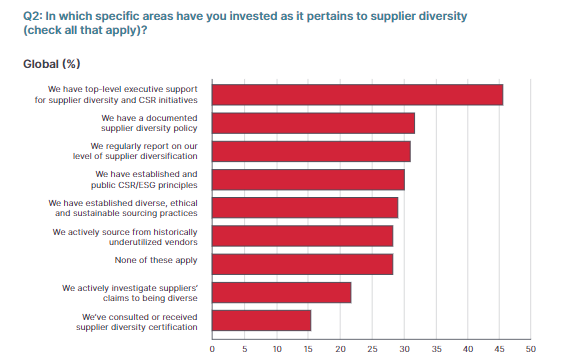5 Steps to Start and Grow Your Supplier Diversity Program
Supplier diversity is a business strategy, not a feel-good story.
Sure, it’s the right thing to do, but it’s also one of the most effective ways to drive real business value, far beyond just procurement.
As more and more boards and C-suites are starting to realize this, it’s falling on procurement and supply chain to actually drive the program.
So, how can you start (and grow) your supplier diversity program?
That video set the stage and gave some tactical advice, but now let’s really dig into how you can put it into practice. Here are my 5 steps to start and grow your supplier diversity program.
Get your supplier diversity questions answered live by a consultant
1. Establish a Business Case and Get Executive Support
Supplier Diversity Starts From Within
Before starting on this path towards supplier diversity, let’s step back and look in the mirror.
Pretty much all of the experts agree, any good supplier diversity program has to start with the right company culture.
JAGGAER CEO Jim Bureau gave his thoughts on this point saying, “I’m a big believer that supplier diversity actually starts with company diversity and culture, because if you don’t have one, you’re likely not going to get the other in a meaningful way.”
It’s not enough for the C-Suite to say, “we need a supplier diversity program.” There needs to be a real culture shift from the top down.
It can be a tough proposition, but when the culture is aligned it’s much easier to get stakeholders on board, set up good processes and drive this strategy forward in a meaningful way.
The rest will start to fall into place naturally. It’s like a domino effect – when people are united around a socially responsible culture, the excitement grows and people start wanting to take ownership of strategies (like supplier diversity).
Building a Business Case for a Supplier Diversity Program
Yes, supplier diversity has become a board level priority in most organizations.
But it’s a priority that typically falls on procurement and supply chain to execute on.
That means it’s your responsibility to create:
- The What: Come up with a strategy that maps back to company goals
- The Why: Have a way to measure success and show ROI
- The How: Clearly communicate the goals, tactics and how it will actually happen
Maybe not a traditional ‘business case’ where you’re trying to get leadership support, it still rests on your shoulder to educate stakeholders, secure their buy-in and show progress and value to the board/C-Suite.
Luckily, supplier diversity programs provide no shortage of benefits, both tangible and intangible.
These include supply chain resiliency, collaboration and innovation, CSR (brand image), cost savings, plus the community and economic impacts.
Sometimes you’ll have to look beyond the obvious, supplier diversity really does impact the entire organization and you need to figure out what each stakeholder cares about in order to get their buy-in.
Getting Executive Support
Chris Sawchuk said, “the main sponsor for supplier diversification within our companies came from the CPO of our organizations, but what we have seen over the last year is the elevation of this issue as a focus and interest area for CEOs as well as the board of directors.”
However, just their sign-off isn’t the end of the conversation.
It’s very important to get an “executive-level champion,” as Chris called it.
Someone who will be an active voice in and for the organization. Someone who will attend supplier diversity events, network with groups like the national minority supplier development council and be a true sponsor of your supplier diversity program.
It doesn’t just need to be leadership from your procurement function either, the more organizational support the better, but this person will be the main driver for both your internal culture and your external supplier diversity program.
Odds are, especially if your company culture is right, there’s someone who’s already passionate about diversity and who would love to be involved in spearheading the supplier diversity program.
2. Create a Policy & Identify Diverse Suppliers
Now that you’ve grabbed your organization’s attention, educated stakeholders and gotten your internal champion onboard, you can begin to develop your supplier diversity program.
The first step is just to create a policy.
That may be a “water is wet” statement, but we’ve all seen where strategies and initiatives get talked about for weeks but nothing real ever happens.
It can be as simple as setting a rule that for every X amount of RFPs you conduct, at least 10% of suppliers invited need to be diverse.
The main thing is that you create a policy to get the ball rolling. People need to see action to motivate them and you can improve the program as you go.
Next up is to identify diverse suppliers, and you can do this is a number of ways.
Collaboration
Do your research and find other companies with existing supplier diversity programs as well as those who are just starting out.
Check out industry groups, LinkedIn communities, Reddit threads or just ask around at the next conference you attend.
Collaborating with your peers can provide a wealth of knowledge, support, or even just a sounding board for potential ideas.
You can get actionable and reliable information on diverse suppliers in your field and advice on supplier diversity initiatives as a whole.
There really is nothing more valuable than talking to others in your situation or people who have been in your shoes and worked through it.
Attend Supplier Diversity Events
There are a number of events and groups that exist to promote supplier diversity and provide networking opportunities.
Getting involved with groups like the national minority supplier development council and others can be a valuable resource to find diverse suppliers, connect with other like-minded organizations and establish best practices.
Here are a few groups to get you started:
- NMSDC – National Minority Supplier Diversity Council
- WBENC – Women’s Business Enterprise National Council
- USPAACC – US Pan Asian Chamber of Commerce
- USHCC – US Hispanic Chamber of Commerce
- NGLCC – National Gay & Lesbian Chamber of Commerce
- NaVOBA – National Veteran-Owned Business Association
Like Chris said in the opening video, there is also a ton of value to be had in hosting your own event. Just by simply hosting a supplier networking event and inviting diverse suppliers to the table you can get valuable insights.
Leverage Technology
Trying to execute supplier diversity without the help of technology is a tall task.
I may be a bit biased working for a technology company but having a system that can segment your supply base, help you visualize where you are today in terms of spend, diversity and even find potential diverse suppliers thanks to natural language processing is a powerful tool to have in your belt.
Aggregating all of that data into one visual dashboard can help you set your baseline, establish goals and KPIs and will make proving the ROI of your program much easier.
That’s where we excel at JAGGAER with the help of our partners like TealBook.
Want to see it in action? Get in touch today to set up a demo.
3. Invest in your Supplier Diversity Program
Creating a strategy is great but if you don’t actually invest in your supplier diversity program it won’t get very far.
And shockingly, according to Chris at The Hackett Group, only about 1/3 of organizations actually put any budget towards supplier diversity, a stat that he acknowledged is changing quickly.
First things first, like I mentioned before you need someone to head up this program.
While it’s not a set requirement to hire someone or create a new job role solely for leading your supplier diversity program, it is strongly recommended to get the most out of your efforts.
Supplier diversity is meant to be very proactive and involved and will eventually need a dedicated professional in order to take your program to new heights.
To go along with a personnel investment, as mentioned above, a technology investment can bring significant value to your organization.
The right solution can streamline your supplier diversity program by identifying the right minority-owned businesses for your vertical or product, helping to segment and manage your supply base and providing analytical insights to bring visibility into performance and ROI.
A good supplier diversity program also requires a significant time investment.
Simply onboarding a set of small and diverse suppliers is only the first step. You need a program for training, mentoring, and networking.
Chris said, “How do we mentor them, how do we create environments so it’s easier for them to engage, to actually become a supplier for us? Many of us have very large organizations; it’s very difficult to navigate these organizations. How do we mentor them to be able to better engage with us, to respond to RFPs correctly, to better work through the risk assessments that we put all of our suppliers including our diverse suppliers through?”
Sometimes that’ may be as simple as just explaining the value of getting a diversity certification, other times it may be more involved.
It must be a true relationship with these suppliers where both sides are offering value and growing together.
4. Establish Goals and Best Practice
You need to establish a set of KPIs and goals and constantly evaluate your process.
What does success look like to you? What do you want to get out of your supplier diversity program?
Remember this is a business strategy first and it should drive real value if done correctly. How do you want to measure that?
This will vary between every company, but it’s crucial to have these goals clearly defined in order to measure your supplier diversity program’s effectiveness.
These should be reviewed and adapted periodically as your organization’s needs and strategies change, this is a dynamic strategy, and you should always be looking for ways to improve.
5. Keep an Eye on Performance
It seems pretty straightforward, but you’ll be surprised at how many times I hear about a company setting up a program and then never going back to evaluate their KPIs or measure progress.
These will vary based on your needs and goals, but here’s a few to get you started:
- Number of new diverse suppliers onboarded
- Number of diverse suppliers invited to an RFP
- Percentage increase of diverse spend
- Savings from your supplier diversity program
- Increase in internal customer satisfaction
- Economic impact (e.g., jobs created)
- Impact in your local communities
- Brand enhancement metrics
Not all of these will have a dollar figure attached.
Chris said “We’re seeing less of the more traditional measures that we look at in the rest of our supply base – cost savings and some of those hard figures. We’re seeing more focus on is supplier innovation, brand perception, how it’s affecting talent, and some of these other softer metrics.”
Some will be qualitative but often those are the most important ones.







